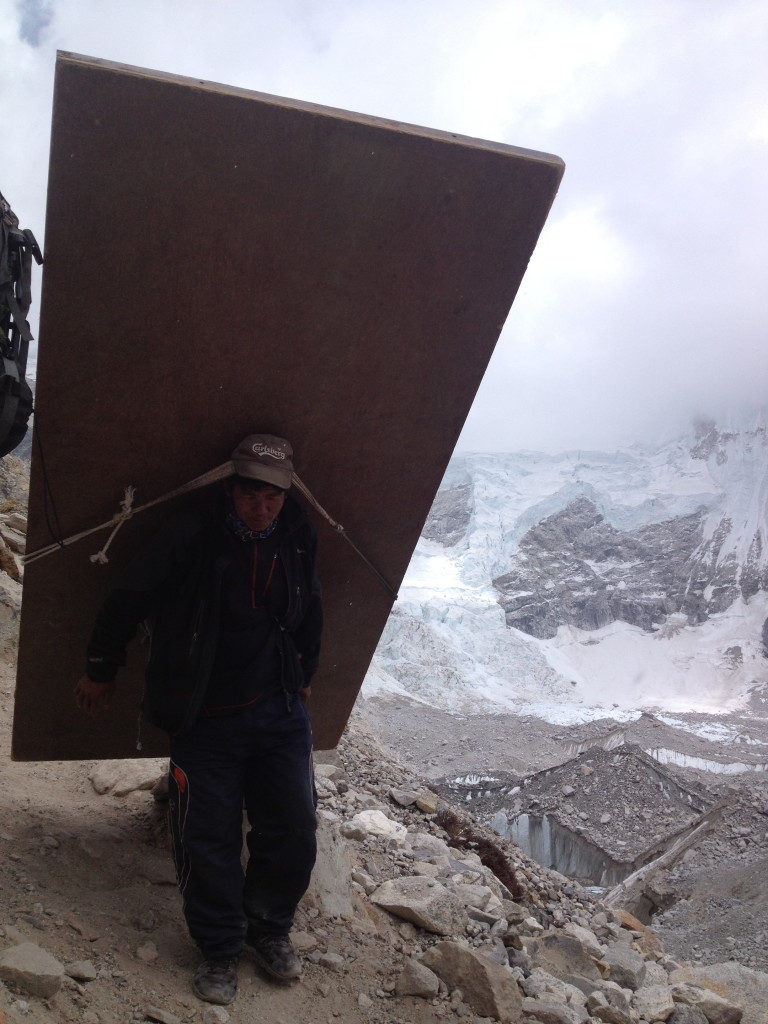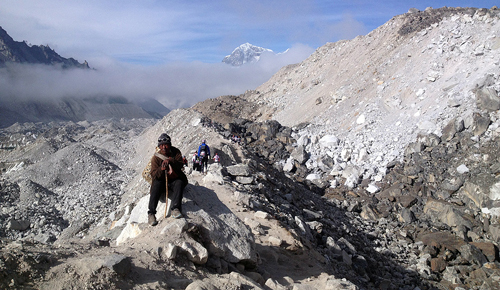UPDATE, April 18, 2014: The worst accident in the history of Mount Everest occurred today, when an avalanche swept across the Khumbu Icefall and killed twelve Sherpas.
Ever since 1953, when Sir Edmund Hillary and Tenzing Norgay became the first people to reach the summit of Mount Everest, many more have aspired to follow them to the top of the world. Every year, hundreds of foreign adventurers climb Everest—at 29,029 feet, Earth’s highest peak—each paying tens of thousands of dollars for the opportunity.
For these tourists, conquering Everest is often a lifelong ambition. But for their local guides and porters, it is a mere job—albeit a dangerous and well-compensated one. A porter carrying goods to the Everest base camp on Nepal’s border makes an average of nine dollars a day, more than three times the daily wage of a typical worker in Nepal. High-altitude workers can earn much more: hiring a Sherpa to climb with you costs $5,000 to $7,000, plus tips and bonuses.
And yet few workplaces boast as high a mortality rate. Just last year, eleven people died attempting to scale Everest—the largest death toll since 1996, the mountain’s deadliest year, when over two days alone a blizzard led to the deaths of nine climbers (a disaster documented by Jon Krakauer in his book Into Thin Air).
The photographs above document my travels last summer through the mountains of Nepal. I began my journey in the northeastern district where Everest is located, Solukhumbu. Later, I spent several weeks with a team of Nepalese mountain guides training in Kakani, one hour north of Kathmandu. In exploring the trails and talking with numerous guides who have worked the Himalayan peaks, I gained a sense of the ambivalence that locals have about the growing international popularity of Everest, which in recent years has brought them rising shares of both bounty and danger.
One of over 120 ethnic groups in Solukhumbu, the Sherpa ethnic group has come to control the tourism and mountaineering industry in the district, and their name has become synonymous with the trained personnel who help foreigners up the slopes (Norgay, a Nepalese Sherpa, paired up with the New Zealand mountaineer Hillary on Everest’s first successful ascent). For some Sherpas, the work they do above the clouds is a calling. “Some people like to drink; some people like to climb mountains,” says Indra Rai, a Nepalese mountain guide in his mid-twenties. “I like the mountains.”

Everest is not for amateurs. Foreigners who seek to scale it from the south must first make a two-week trek to the base camp and then spend six to eight weeks acclimating their bodies to the thin mountain air before the five-day climb to the peak can even begin. But as grueling as the journey is for Everest’s newcomers, the veterans who lead them skyward have a much more challenging task: setting up fixed lines and ascenders—secured ropes, and the metal devices that clamp onto those ropes, which climbers use to hoist themselves up the mountain.
“We climb twice,” says Chhiring Dorje Sherpa, a Nepalese mountain guide in his early thirties. (The ethnic group’s name is also used as a surname in Nepalese culture.) “First, we go up to set the ropes and camps, then we go down to collect our clients and take them to the top.” Often, those fixing the ropes are not just Nepalese Sherpas, but mixed teams of Nepalese and Pakistani guides—working together in spite of the language barrier.
The demand for these mountain men (and women—Sherpas are known to be relatively respectful of gender equality) is increasing. On May 23, 2010, there were more successful ascents of Mount Everest—169—than had occurred in the three decades since Hillary and Norgay first reached the peak. The influx of climbers in recent years has been a boon to Solukhumbu’s economy. Foreigners do not simply employ Sherpas on the mountaintops; they also stay at the family-owned guesthouses scattered along the path to Everest.
Pasang Karesh, forty-five, owns one such guesthouse in Gorak Shep, the Nepalese town closest to Everest’s southern base camp. He speaks of how the tourist boom has transformed the area: the trails are becoming more commercialized, he says, with the outsider-driven demand for accommodations and food supplies spurring gentrification. The recent changes include the construction of a mobile tower in Gorak Shep several years ago—explicitly built to cater to those on the mountaintops who wanted an alternative to costly satellite phones.
As more people from around the world muster the resources (and recklessness) to scale the world’s tallest peak, Everest has itself become commercialized. Privileged Westerners come by the droves to “climb for a cause”—from child poverty to water conservation. Scaling the peak has become just another goal for some to check off on their life’s bucket list.
More worrisome, the mountain’s slopes have become crowded, a situation that veteran mountaineers deplore as dangerous. More than 200 people have died on Everest, and even though fatalities happen less frequently these days, the recent surge in climbers has meant that more than a quarter of those deaths have occurred since 2000. There is a very narrow window between May and June when Everest’s slopes are relatively less perilous, and during that time hundreds of climbers can crowd the so-called “Death Zone”—altitudes above 26,000 feet, where oxygen becomes scarce and mental faculties quickly deteriorate. (Climate change may also be making the climb more lethal, as the mountain’s layers of ice and snow melt and leave the path rockier and more treacherous.)
Last year, an expedition went up Everest to clear debris and retrieve the abandoned corpses of previous climbers. The five-person team ended up having to wait four hours in the Death Zone, as climbers going up “Hillary’s Step”—a sheer rock wall just below the summit—jammed the path down. A South Korean climber died, one of Everest’s four fatalities that day.
Nima Sherpa, a twenty-nine-year-old medic, ticks off the many afflictions that beset those who venture into Everest’s unrivaled altitudes: frostbite, snow blindness, hypothermia, delirium. The Sherpa guides who risk their lives climbing the Himalayas’ toughest peaks cannot dwell on these dangers, though: they have families to support. “The pay is good, and this is their work,” he points out.
And yet that is, perhaps, part of the problem. “When your family needs that money,” another guide says, “sometimes you don’t insist a weak climber turn back.”
Stephanie Lowe is an adventurer and storyteller. She is the founder of Playfull Productions, a firm dedicated to educating and empowering through play.
- Follow us on Twitter: @inthefray
- Comment on stories or like us on Facebook
- Subscribe to our free email newsletter
- Send us your writing, photography, or artwork
- Republish our Creative Commons-licensed content

